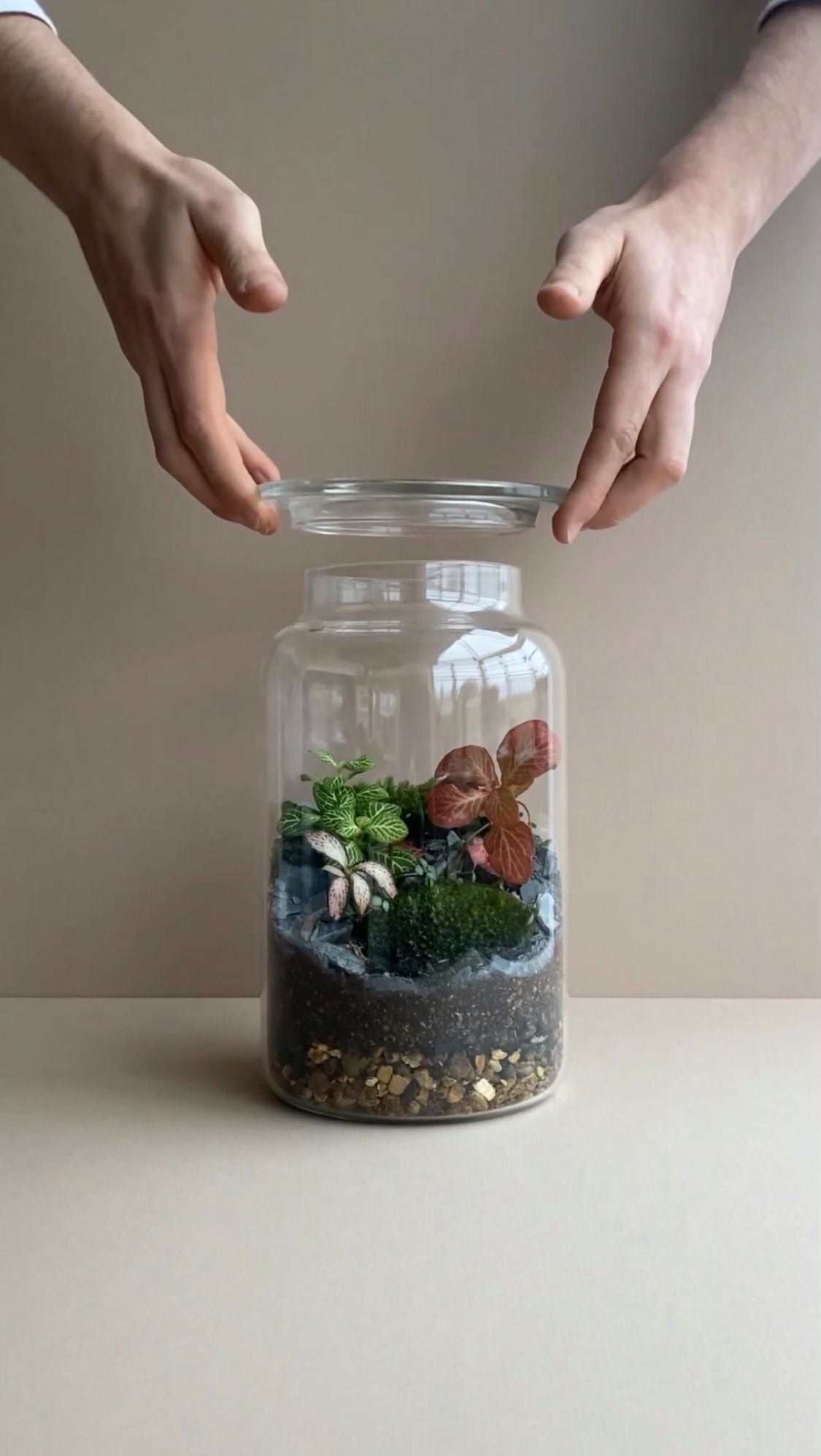
Terrarium Care
It is a joy to learn the individual identity and preferences of your terrarium, but thankfully there are some basic care principles that, if followed, should keep any little closed ecosystem healthy and happy.
Find answers to the most common terrarium care questions in our guide below!
Collapsible content
Terrarium care? I thought they care for themselves!
Terrariums are low care, not no care! The only self sustaining ecosystems in this world are the complex and beautiful natural ones that nature has created herself. The further a plant is from the conditions it naturally grows in, the more we need to intervene to keep it happy. This explains why cacti and succulents (aridity loving plants) are easier to look after in your home environment (a warm dry place with no rain, i.e. a desert) than plants that have evolved in a rainforest.
Closed terrariums create a very humid environment that is much closer to a rainforest than the ambient conditions in your home. They also have their own water and nutrient cycle, substantially lowering the number of interventions you need to make to keep the plants happy. They are not, however, a perfect replica of the evolutionary home of the plant; no terrarium is. There will always be a need for you to take small actions on occasion - a teaspoon of water here, a little trim there.
Fortunately, when we say low care, we mean low care. If a terrarium gets well balanced they can go for a long time before they need a nudge to keep them on track. You can read all about terrarium care in the guide below, and we’re here for any questions you might have as you venture into the wonderful world of terrariums!
Placement
Terrariums enjoy bright, indirect light, and placement away from heat sources including radiators.
When exposed to strong direct sunlight or heat, the terrarium suffers a dramatic greenhouse effect, cooking your plants and leaving you with a rather sorry terrarium!
We recommend placing your terrarium within 2m of a window and out of direct sunlight. Prime position would be next to a north facing window. Darker spots should be avoided, as this can result in unwanted mould growth.
Watering
The tropical plants in our closed terrariums enjoy high levels of humidity. As the water inside the terrarium is largely recycled rather than released, terrariums need surprisingly little watering! One very well sealed terrarium was famously last watered in 1972 as none of the water has escaped! We don’t try to make a perfect seal on our terrariums, in our experience its best to let them breathe a little, so you will need to replenish water escaping from the vessel.
The watering frequency varies significantly depending on ambient humidity and temperature, how often you ventilate, and the strength of the seal. It can range from as little to a teaspoon every six months, to every few weeks!
The amount of watering will largely depend on how much you ventilate your terrarium (see the ‘Ventilation’ section for guidance on this. - in brief, we recommend opening once every few weeks for 30 mins to an hour, and adding a teaspoon or two of water occasionally to replenish this. The quantity of water you add will vary depending on the temperature and humidity of your home, so do use the appearance and feel of the plants as a guide).
An under-watered terrarium is far easier to rescue than an over-watered terrarium, so restraint is key.
When watering, best practice is to add approximately one to two teaspoons of filtered water to the inside of the glass. You can alternatively use cold chamomile tea as its high sulphur content gives it helpful antifungal properties! The objective is for the plants to feel firm and springy to the touch and the moss to be slightly moist (like a well wrung out sponge). If you see plants wilting or leaves browning or crisping these can be signs of dehydration warranting intervention. Add a teaspoon or two more water every few days until the plants are once again feeling firm to the touch and the moss is feeling damp. Using this method, you will eventually learn the watering frequency required for your terrarium to thrive in your home environment, and can compensate correctly for water lost during your ventilation routine.
If a particular plant wants water but the others seem fine, you can also water on a localised basis next to the stem of the affected plant.
If you have a mossarium (a terrarium dominated primarily by mosses) then you may need to spray the moss with filtered water a little more frequently than with our larger terrariums to keep it happy. Mossariums tend to enjoy much higher moisture levels, and moss in a mossarium should never feel dry or crispy!
Ventilation
While some people do keep their terrariums sealed indefinitely, this does increase the chances of mould and algae growth and we really don’t recommend it. Life will continue in a tightly sealed terrarium, but it may not be the life forms that you enjoy looking at! We suggest that you take the lid off to let in fresh air for 30mins to an hour or so every few weeks. This will refresh the air while maintaining the consistent high humidity that our tropical plants adore. Don't forget to add a little water afterwards to replenish water lost to evaporation!
Pruning
The plants in your terrarium, like all other plants, will have a tendency to grow! To keep them in optimum health, we recommend pruning them if they get too large! This will keep everything balanced and ensure one particular plant doesn’t prevent others from thriving.
Use sharp scissors and wash them thoroughly before use. As a general rule, ensure you are leaving at least four leaves on any plant you trim, and try not to remove more than 30% of the plant at once.
Some of the plants we use (such as fittonia) can actually be water propagated, so why not put your cuttings in water to root then plant them up in a little pot for a friend?
Be sure to remove any fallen leaves or dead plants to ward off mould outbreaks!
Problems
Bugs in my terrarium!
In most instances this is not actually a problem! All our terrariums contain tiny white isopods called springtails. Most of the time, you will never even know they are there (they are only a couple of millimeters in size). You can thank them for the important role they play in keeping your terrarium healthy. Springtails feed on mould outbreaks and provide your plants with the nutrients they need to survive!
Mould
If you see mould in your terrarium, don’ t panic! It is a very common and entirely normal part of terrarium life and we expect every terrarium to have some at some point! Remove what you can with a paper towel or cotton bud then ventilate the terrarium by leaving the lid half-open for a while (you will need to keep an eye on the plant health in the interim - the aim here is to dry out the mould but not the plants! Most of our plants are rather tolerant but the moss can be a little shocked by the drop in humidity - localised watering of the moss can mitigate this.) Make sure your terrarium is in bright indirect sunlight and, when watering is needed, use cold chamomile tea (it has wonderful antifungal properties). Both the tea and ventilation will slow mould growth, and the springtails in the terrarium love to eat it, so they should help bring it back under control! Finally, the nuclear option is hydrogen peroxide 3% which can be dabbed onto the mould with a cotton bud. This can be very effective at clearing small outbreaks. A little mould is a common occurrence in a terrarium and is generally not harmful to healthy plants - its just another tool in nature’s toolkit to keep the ecosystem balanced!
Overwatering
If you’ve overwatered your terrarium, don’t panic. Its a mistake we’ve all made and thankfully all our terrariums are built with high quality substrate and drainage layers to delay the onset of problems associated with waterlogged soil. To save an overwatered terrarium, wipe away the condensation on the side of the terrarium on a daily basis and leave the lid off. It may take a while, but eventually the water will evaporate. Just be sure to keep an eye on the health of the plants while they are exposed to our dry indoor air!
Underwatering - see ‘watering’ section above.
Terrarium Mushrooms
Occasionally mushrooms grow in terrariums - when you see them you can easily remove them by gently picking them from the soil. Mushroom spores are everywhere and it is inevitable that some will make their way into your enclosure! The mushrooms create amazing fungal networks around the roots of your plants which serve really important symbiotic functions, providing your plants with nutrients to thrive. Consider them another beautiful little facet to the evolving ecology of your little plant world! It is a good idea to take them out before they open and release their spores, and certainly before they die as a large quantity of decaying matter can cause an mould bloom!
One of my plants died/has dropped leaves
If this happens, remove the dead plant/leaves from the environment to avoid a potential mould bloom. Take an opportunity to check if the terrarium is under or overwatered and add water or ventilate as appropriate.
I have accidentally left it in direct sunlight!
Well unfortunately it happens, relocate your terrarium to a more forgiving spot and remove any dead plants. If its looking a little sparse, perhaps visit the tropical plant section of your local independent plant shop or garden center. Small ferns, fittonia, ficus, and all manner of other small humidity loving plants would make good additions! Just make sure the plant you are buying is a small variety and not a young plant that is destined to grow much larger!
What to do if the worst happens
Terrarium plants, like all other houseplants, are sadly not immortal. Just like humans, they are vulnerable to disease and will struggle if their needs aren’t all well met.
If some or all of the plants in your terrarium die, don’t panic! We have lost many plants to the greenhouse in the sky and this really doesn’t make you a bad plant parent.
The good news is that, unless you have had a severe mould outbreak that has overwhelmed the terrarium, you can simply remove the dead plants, rehydrate the soil if its a little dry and plant some new plants!
If there has been a severe mould bloom, we recommend removing all the plants and soil, thoroughly cleaning the stones in the base, the filter, and the glassware, before replacing them and adding some activated charcoal (or crushed charcoal if you cant get hold of this) and new terrarium soil and plants.
Terrariums, like all manually cultivated plants and gardens, benefit from a spruce up from time to time, and adding new plants and isopods as others reach the end of their natural life cycle is part of the joy of indoor gardening! If you decide that the world of terrariums is no longer for you, you can give it to a friend or empty the jar and use it for biscuits or domestically grown flowers! If you must dispose of the jar, please donate it to charity, or at the worst, recycle it. Terrapy has a zero landfill ethos.
Any questions?
If you have any terrarium care questions that aren’t covered here, do contact us at hello@terrapy.uk or via any of our social media channels. We want your tiny world to thrive and are always happy to help.
